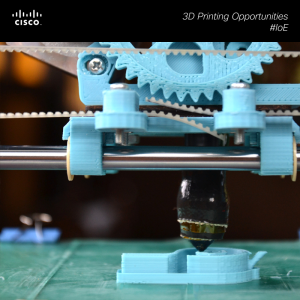































Uniquely Identifying Things Enables the Internet of Everything to Thrive
In February 2014, patents are set to expire on selective laser sintering, the key to industrial-grade 3D printing. This is expected to cause an explosion in 3D printing.
This is expected to cause an explosion in 3D printing.
In a recent interview, GE CEO Jeff Immelt cited his company's rapid adoption of this technology in manufacturing its new line of jet engines. "3D printing allows you to make that product right the first time," he stresses, adding that it is "worth a lot of investment." The UPS Store also sees the importance of this potentially game-changing technology. It is running a test program that will make it the first national retailer in the United States to offer 3D printing services targeted at helping entrepreneurs, architects, startups and other retail customers.
In the Internet of Everything realm, 3D printing promises exciting opportunities by enabling unique identifiers to be printed directly onto a product or product part. In the GizMag article RFID be gone: Why you might soon be 3D printing the Internet of Things, author James Holloway explores the emerging field of terahertz imaging (Tz). Scientists have developed a way to print a unique 3D tag called an InfraStruct, which is added within the object as it is being printed. These tags take on various forms or patterns, giving an object a unique fingerprint, or "watermark". The InfraStrut can be read by a scanner using terahertz radiation. The terahertz band falls between microwave and infrared wavelengths of the electromagnetic spectrum. Current RFID technology requires a chip that can slow the printing process and increases the cost of the item; printed Tz IDs would greatly simplify and streamline the process. Terahertz could ultimately provide new ways to connect certain objects at a lower cost by recognizing items without the need for a chip.
Looking forward, a Tz scanner could be built into your smart phone. You could then scan the aisles at your local retailer for the precise plumbing part to mend your broken sink - or the right color cartridge for your home printer. Retailers, in turn, could associate special deals with your buying history. Scan that sofa through your shopping app and up pops a personal discount aligned with your level of brand loyalty!
The success and growth of the Internet of Everything depends on connecting staggering numbers of people, processes, data, and things. Discovering novel ways of connecting new things -including being able to make those connected objects uniquely identifiable - will continue to be crucial.
What are other ways do you see emerging that will uniquely connect things?
 Tags quentes :
Internet of Things (IoT)
Internet of Everything (IOE)
IoE
network connections
Tags quentes :
Internet of Things (IoT)
Internet of Everything (IOE)
IoE
network connections